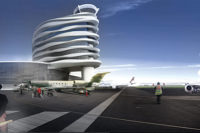Eye-Like Skylight Design on atop Fulton Center
Radius Track takes on the giant oculus in Manhattan.




The design and fabrication of the giant skylight oculus atop the Fulton Center in the Lower Manhattan district of New York has been completed by Radius Track. As the most striking design feature of the new transit and retail hub, the daylight-delivering oculus brings natural light deep into the building via the glass-enclosed central atrium.
When complete, Fulton Center will simplify the maze of platforms, entrances and exits around the eleven subway lines that serve Lower Manhattan. It will also provide an underground connection between those lines and the Port Authority of New York and New Jersey’s PATH train hub, the World Trade Center, and the ferries at the World Financial Center. Fulton Center will be a retail destination with over 70,000 square feet of leasable space.
PRECISION AND PLANNING
|
Owner: Metropolitan Transportation Authority Capital Construction Design Architect: Grimshaw Architects General Contractor: Plaza-Schiavone, Joint Venture Architect of Record and Engineer: Arup
Interiors Subcontractor: The Donaldson Organization/
Exterior Stainless Steel Metal Enclosure Contractor:
Oculus Curved Panels: Radius Track Corporation NCI Panel Systems (Subcontract Assembly) THHinc (Consulting Engineer) |
During the planning process, Radius Track demonstrated its approach to manufacturing and installing pre-fabricated panels made specifically for projects that challenge conventional architecture. Engineers worked with the task of enclosing the cone-shaped profile with custom-shaped steel panels in order to support the space-animating skylight. Working against a tight construction schedule, the company created a special sequencing system from an offsite location to cut down on building costs and set the construction team up for a seamless installation process.
The manufacturer was responsible for lining the oculus in 8-foot panels. The oculus base (conical section) measures almost 60 feet tall at its highest point and spans 90 feet across at its base diameter, covering a total surface area of 8,294 square feet. The job required 44 panels, each measuring about eight-feet wide and 19-feet long. Organized in two tiers and fit together with expert precision, the panels highlight the company’s skills of 3-D computer modeling, accurate and economical detailing, specific attention to connections, and cutting edge technology.
Housed atop a large glass structure, the oculus’s glass ceiling allows light to stream into the interior space below and addresses the station’s former problems with low lighting. The oculus sits on a large, truncated (or sliced at an angle) cone that is positioned atop a glass box that encloses the building. Grimshaw Architects, the design architect, with Arup, the architect of record and engineer, designed the building for the Fulton Center to solve the safety and aesthetic concerns that marred the old space. Formerly an old dark subway space, the new space is “enlightened” by the new oculus centerpiece, serving as a sky lit sunroof.
IMPORTANCE OF CRAFT
“Radius Track brought clarity to the process of engineering the pre-fabricated dome panels by ‘quarterbacking’ online meetings using advanced BIM tools,” says Kevin Haney, project manager at Plaza Construction in New York City. “Radius Track delved into the nitty-gritty details and shared them with us right on our screens, enabling the design team to make decisions during meetings, instead of pushing them off to later. Radius Track CEO Chuck Mears’ mastery of collaborative software brought our team together instantly and effectively. Even with many team members right in New York City, it was still helpful to meet online because travel time in the city can eat into schedules quickly.”
Allen Kasden, project executive at Plaza Construction, agrees. “Radius Track’s expertise in 3-D modeling greatly benefitted both us and the Donaldson Organization, the interiors subcontractor.”
“We had originally envisioned this project to be stick built,” says Matt Zettwoch, project manager at the Donaldson Organization. “The idea of creating pre-fabricated panels offsite which could be installed onsite saved us a great deal of time and labor costs. We did the installation in two-and-a-half weeks and averaged seven panels a day. It could have been a far different story had we created the oculus walls and parapet onsite.”
“We see our work on the Fulton Center oculus as an important breakthrough in the delivery of a challenging design concept,” says Mears. “New York City is iconic for its transportation systems, and it’s exciting to be a key contributor to its latest statement piece which continues that pacesetting leadership.”
The Fulton Center, expected to be completed in 2014, highlights the challenges of constructing buildings high above ground, especially in dense urban settings like New York City. It is an exceptional case study of how the combination of 3-D modeling and framing prowess can save time and money. W&C
Looking for a reprint of this article?
From high-res PDFs to custom plaques, order your copy today!









